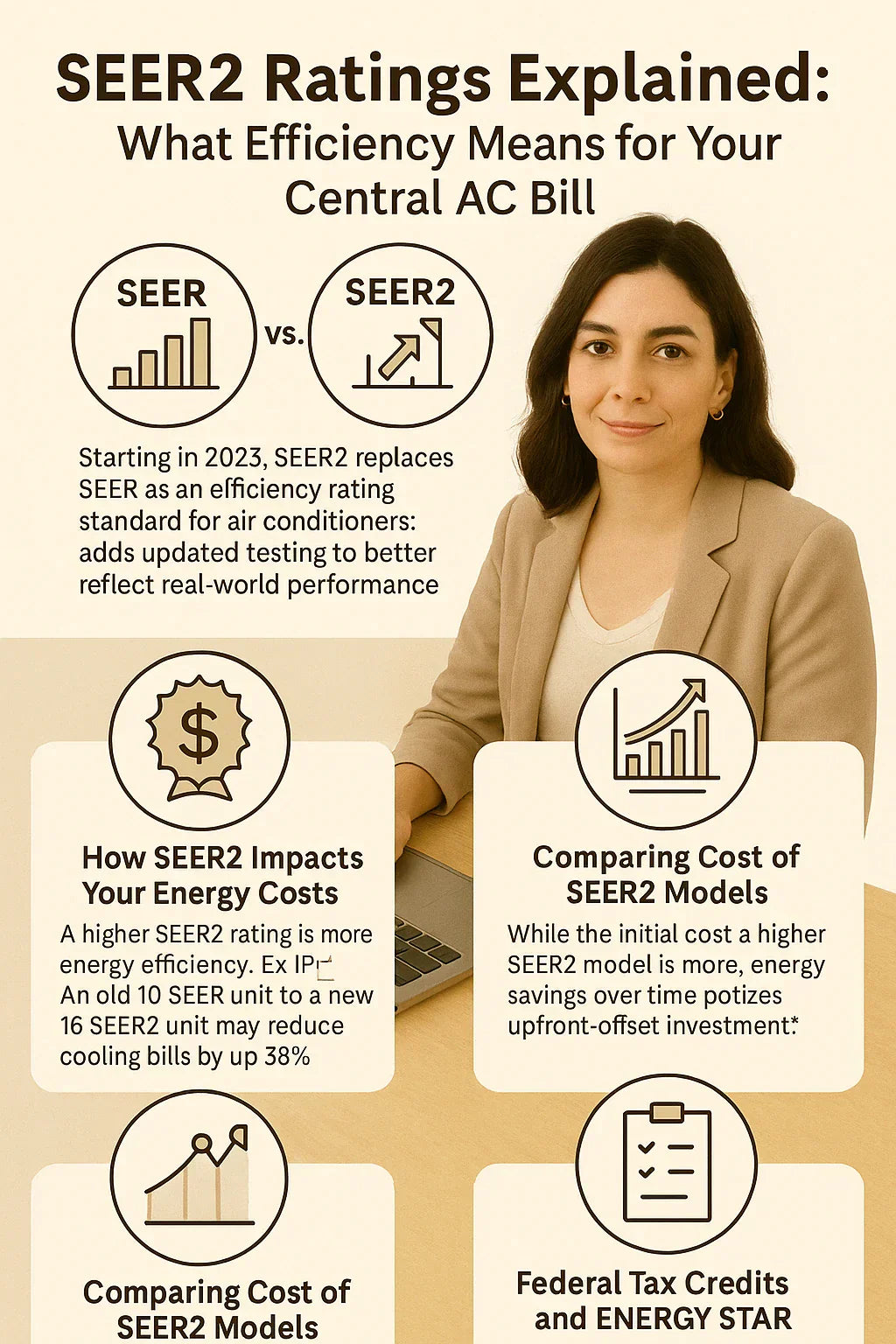🔄 Introduction: Why SEER2 Matters More Than Ever
When you're shopping for a new central air conditioning system, you'll likely see SEER and SEER2 ratings listed prominently. These numbers can seem confusing, but they are critical indicators of how efficient your AC system will be. Understanding SEER2 can help you:
-
Lower your energy bills
-
Qualify for rebates
-
Make smarter, future-proof purchases
In this detailed guide, we'll demystify SEER2, explain how it affects your costs, and show how to choose the most efficient system for your home.
🔬 What Is SEER?
SEER (Seasonal Energy Efficiency Ratio) measures the cooling output of an AC system divided by its total energy consumption during a typical cooling season.
-
Higher SEER = greater efficiency.
-
Measured in BTUs per watt-hour.
-
Example: A 16 SEER system provides 16 BTUs of cooling for every watt-hour of electricity used.
🔬 What Is SEER2?
SEER2 is the updated version of SEER, adopted in 2023 to better reflect real-world operating conditions.
Key differences:
-
Accounts for static pressure in ductwork.
-
Uses stricter testing procedures.
-
More accurate reflection of real-world performance.
The move to SEER2 was made to better represent how systems actually perform in American homes.
For full technical details, see SEER2 standards resource.
🔐 2023 SEER2 Minimums (By Region)
| Region | Minimum SEER2 (Split AC) |
|---|---|
| Northern States | 13.4 |
| Southern States | 14.3 |
| Southwest States | 14.3 (plus EER2 requirements) |
For official regional breakdowns, see DOE's HVAC efficiency standards map.
📈 SEER vs. SEER2 Conversion
Because SEER2 uses more demanding tests, SEER2 ratings are generally about 4.5% lower than SEER ratings for the same system.
| SEER | Equivalent SEER2 |
| 14 SEER | ~13.4 SEER2 |
| 16 SEER | ~15.2 SEER2 |
| 18 SEER | ~17.1 SEER2 |
| 20 SEER | ~19.0 SEER2 |
🔊 How SEER2 Affects Your Energy Bills
Higher SEER2 = Lower Bills
Example savings comparison:
| System | SEER2 Rating | Annual Cost (Cooling) |
| Older System (10 SEER) | ~9.5 SEER2 | ~$900 |
| Basic Modern Unit (14.3 SEER2) | 14.3 | ~$600 |
| High Efficiency (18 SEER2) | 18 | ~$470 |
Assumes 2,000 sq ft home; typical summer usage; moderate US climate.
Upgrading from a 10 SEER unit to an 18 SEER2 model could save ~$430 per year.
Use Energy Star’s savings calculator for a customized estimate.
🤟 Federal Tax Credits & Rebates for High-SEER2 Systems
The 2022 Inflation Reduction Act expanded federal tax credits for efficient HVAC systems:
-
Up to $2,000 tax credit for qualifying heat pumps or central AC systems.
-
Must meet highest efficiency tiers (typically 16 SEER2+).
-
Available through 2032.
For full eligibility details, visit Energy Star's Tax Credits page.
💡 Is Higher SEER2 Always Worth It?
Pros of Higher SEER2:
-
Lower utility bills
-
Increased comfort (better dehumidification)
-
May qualify for incentives
-
Environmentally friendly (reduced carbon footprint)
Cons of Higher SEER2:
-
Higher upfront cost
-
Longer payback period if cooling needs are low
-
Diminishing returns above 20 SEER2 for most climates
🌧️ SEER2 and Humidity Control
Higher-SEER2 systems typically include variable-speed compressors and fans, which:
-
Run longer at lower speeds
-
Remove more moisture
-
Maintain steadier temperatures
-
Improve indoor air quality
🔢 Payback Period Estimates
| SEER2 Upgrade | Estimated Payback |
| 13.4 → 15.2 SEER2 | 5-7 years |
| 13.4 → 18 SEER2 | 7-10 years |
| 13.4 → 20 SEER2 | 10-15 years (or longer) |
🔧 Smart Thermostats Maximize SEER2 Savings
Even the most efficient SEER2 system benefits from proper controls:
-
Smart thermostats adjust cooling based on occupancy.
-
Optimize run times for peak efficiency.
-
Many models qualify for additional rebates.
Compare top-rated models at Consumer Reports' smart thermostat guide.
🔜 Quick SEER2 Buying Recommendations
| SEER2 Rating | Best For |
| 13.4-14.3 | Budget installs; milder climates |
| 15.2-16.5 | Most homeowners (good balance) |
| 18-20+ | High energy costs, hot climates, long-term savings |
Always match your system size and SEER2 rating to your climate, home size, and budget.
🔢 Conclusion: SEER2 Simplifies Smarter Buying
The introduction of SEER2 helps homeowners get a more realistic understanding of air conditioner performance. While higher SEER2 models cost more upfront, they can provide major savings over time—especially in warmer, more humid regions.
Take your time, run the numbers, and consult trusted suppliers like The Furnace Outlet to compare models and efficiency options.
In the next topic we will read about: Central Air Conditioning Installation Costs in 2025 — Real-World Estimates







